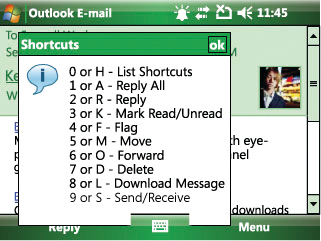Why you can trust TechRadar
Microsoft has encountered two big issues when developing its mobile OS: satisfying the needs of consumers and professionals at the same time, and producing an OS that works well in all three formats supported - SmartPhones, connected PDAs and unconnected PDAs.
It's tried to address both with Windows Mobile 6, while also retaining continuity with Windows Mobile 5.0. The result is more a series of small changes than a big OS development.
It's fair to say that at first glance versions 5.0 and 6 are largely indistinguishable. It's only when you start to use Windows Mobile 6 that the many changes become apparent. Even then you'll only see them all if you work in an office that uses a network based around Microsoft Exchange Server, and you'll need the 2007 version to get the full benefit.
Let's start with the most basic change - naming. Windows Mobile 5.0 came in three versions: Pocket PC, Pocket PC Phone Edition and SmartPhone. Windows Mobile 6 also comes in three versions, and it maps on to each of the three devices.
Windows Mobile 6 Standard is for SmartPhones; Windows Mobile 6 Professional is for SIM-toting Pocket PCs; Windows Mobile Classic is for non-SIM-toting Pocket PCs.
So there are still three versions of the OS. This will disappoint those who were expecting all the different Windows Mobile platforms to come together under one OS with Windows Mobile 6. In the meantime, Windows Mobile SmartPhones retain their non-touch-sensitive screens and slightly diminished feature set.
Moving on up
If all this sounds negative, perhaps we should examine some of the many useful tweaks and changes that have been made. For Windows Mobile SmartPhone users, the best news might be that the ability to edit Word and Excel documents comes as standard.
Don't get too excited, though: the editing capabilities are minimal and you can't create new documents from scratch. There's a viewer for PowerPoint documents too, and the lot - Word Mobile, Excel Mobile and PowerPoint Mobile - are bundled together as 'Office Mobile'.
More useful on a day-to-day basis are features such as support for HTML email, email-sorting improvements and shortcuts. Keyboard or number pad shortcuts now give you access to email features such as reply, forward and send/ receive.
Hitting a number should make handling email a lot faster. Searching emails is easier too, with a system similar to Windows Mobile smart dial having been implemented. You just go to the inbox, start to type a word and the software narrows down all the emails until only the ones containing your term are shown.
HTML email is a boon, with hyperlinks taking you to web pages, or phone numbers in emails being 'live' so you can dial by selecting them. Windows Live is included, and it features Live Messenger (replacing MSN Messenger) and goodies like multi-person chats and file exchange over IM. It can't, however, integrate with other IM clients.
It's now much easier to use a Windows Mobile 6 device as a modem thanks to the Internet Sharing utility. You don't need to do any driver download or installation - just making a link between device and notebook computer is enough to get you up and running. Another tweak we like is the 'busy bar' in the Today view of the Calendar, which lets you see when you have free time.
Sadly, there's a long list of features we'd have liked to see that have been left out. For example, Windows Media Player is unchanged, and Internet Explorer still doesn't allow you to open two browser windows at once.
Nor can you easily close down applications - the 'X' minimises them but leaves them consuming memory. It seems the really significant improvements will come some way down the road, if we ever see a Windows Mobile 7. Don't be surprised if the next big SmartPhone OS ends up being Vista Mobile...
